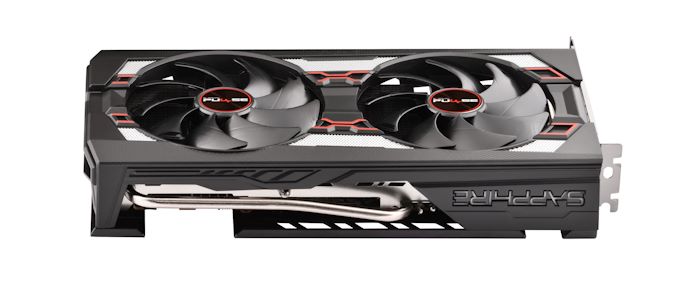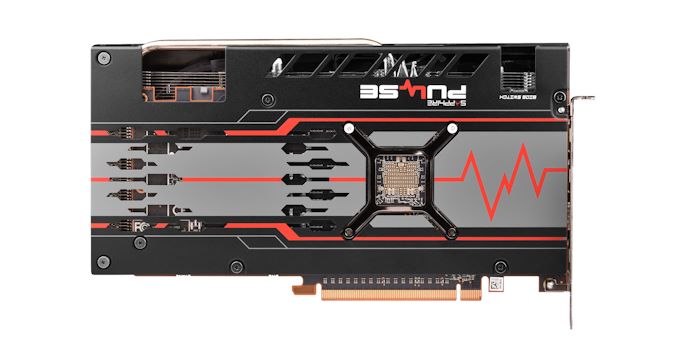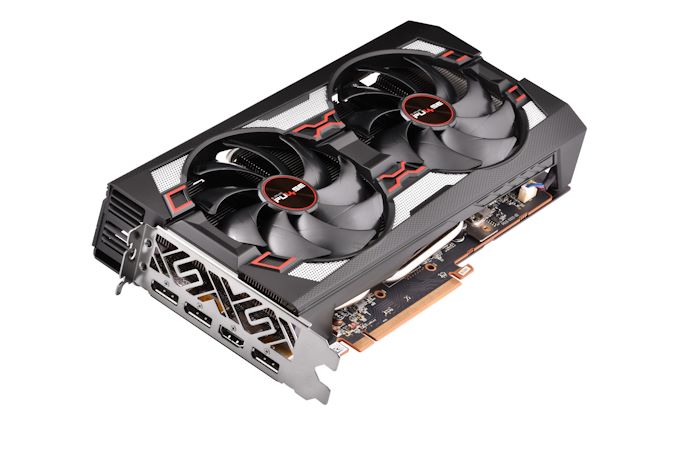The AMD Radeon RX 5600 XT Review, Feat. Sapphire Pulse: A New Challenger For Mainstream Gaming
by Ryan Smith on January 21, 2020 9:01 AM ESTMeet the Sapphire Pulse Radeon RX 5600 XT
Shifting gears, let’s talk about the actual hardware that will be hitting retail shelves today. As I mentioned towards the start of the article, AMD isn’t launching an official reference RX 5600 XT, so today’s launch is all about partner cards. To that end, AMD has sampled us with Sapphire’s Pulse RX 5600 XT. Sapphire’s card is a moderately factory overclocked card, and following AMD’s BIOS changes, is apparently a good example of what AMD wants other partner factory overclocked cards to be like.
| Radeon RX 5600 XT Card Comparison | |||||
| Radeon RX 5600 XT (Reference Specification) |
Sapphire Pulse RX 5600 XT (Quiet Mode) |
Sapphire Pulse RX 5500 XT (Default/Perf Mode) |
|||
| Base Clock | 1290MHz? | 1290MHz | 1290MHz | ||
| Game Clock | 1375MHz | 1460MHz | 1615MHz | ||
| Boost Clock | 1560MHz | 1620MHz | 1750MHz | ||
| Memory Clock | 12Gbps GDDR6 | 12Gbps GDDR6 | 14Gbps GDDR6 | ||
| VRAM | 6GB | 6GB | 6GB | ||
| TBP | 150W | ~150W | ~180W | ||
| GPU Power Limit (TGP) | N/A | 135W | 160W | ||
| Length | N/A | 10-inches | |||
| Width | N/A | 2.3-Slot | |||
| Cooler Type | N/A | Open Air, Dual Fan | |||
| Price | $279 | $289 | |||
Editor's Note: These are the specs post-BIOS update. Anyone buying the Pulse in January will want to make sure to update their card with Sapphire’s new BIOSes
Sapphire has several sub-brands of cards, including the Nitro and the Pulse. Normally the Nitro cards are their higher-priced factory overclocked cards, while the Pulse cards are more straightforward. But following AMD’s BIOS changes, that seems to have at least partially gone out the window. In any case, even with its factory overclock the Sapphire Pulse RX 5600 XT is not being positioned as a high-end card among RX 5600 XTs; at $289, it carries just a $10 premium over AMD’s MSRP.
For their Pulse RX 5600 XT cards, Sapphire has opted to factory overclock both modes for the card. The card’s default mode, which is its performance mode, ships with a ~180W TBP. This affords a rather sizable 240MHz (17%) increase in the card’s rated game clock. Meanwhile the memory clock has been increased by 2Gbps (17%) to 14Gbps. In short, in performance mode the Pulse is noticeably more powerful (and power-hungry) than a baseline RX 5600 XT.
On the flip side of the coin is the card’s quiet mode BIOS. This BIOS uses settings much closer to AMD’s own reference specs, with the 150W TBP and 12Gbps matching AMD’s. The only change here is that the card gets a milder 85MHz (6%) factory overclock, as far as the game clock is concerned.
Digging into the card, it’s clear from the start that Sapphire has overbuilt the card, particularly for cooling performance. At 10-inches long the card isn’t especially lengthy, but Sapphire makes up for that with a 2.3-slot wide cooler design and significantly taller (5.3-inch) frame. Comparing it to NVIDIA’s relatively compact dual-fan GeForce RTX 2060 Founders Edition, the Sapphire Pulse RX 5660 XT has about 50% more volume. Which, along with making the card a bit of a pain to install, affords it a lot more volume for heatsinks and fans.
The payoff for this oversized design is that Sapphire can use larger, lower RPM fans to minimize the fan noise. The Pulse 5600 XT packs 2 95mm fans, which in our testing never got past 1150 RPM. And even then, the card supports zero fan speed idle, so the fans aren’t even on until the card is running a real workload and starts warming up. The net result is that the already very quiet card is completely silent when it’s idling.
Meanwhile beneath the fans is a similarly oversized heatsink, which runs basically the entire length and most of the height of the board. A trio of heatpipes runs from the core to various points on the heatsink, helping to draw heat away from the GPU and thermal pad-attached GDDR6 memory. The fins are arranged horizontally, so the card tends to push air out via its I/O bracket as well as towards the front of a system. The card also comes with a metal backplate – no doubt needed to hold the oversized cooler together – with some venting that allows air to flow through the heatsink and out the back of the card.
Feeding the beast is an 8-pin external PCIe power cable, as well as PCIe slot power for its electricity needs. From a practical perspective this is well-provisioned for a card that will hit 180W, and with the design presumably being recycled from a 5700 series design, there’s room for a second power connector if Sapphire ever needed it.
Finally for hardware features, for display I/O we’re looking at a pretty typical quad port setup. Sapphire has equipped the card with 3x DisplayPort 1.4 outputs, as well as an HDMI 2.0b output. With daisy chaining or MST splitters, it’s possible to drive up to 6 monitors from the card.














202 Comments
View All Comments
Korguz - Wednesday, January 22, 2020 - link
TheinsanegamerN but the everage user.. wont overclock.. so thats not really valid....haukionkannel - Thursday, January 23, 2020 - link
There Are test where there Are OC 5600xt and OC 2060 And They were quite near each others!For example Hardware Unboxing did use OC msi cards from both gpu manufacturers.
Spunjji - Wednesday, January 22, 2020 - link
I'm guessing the answer most would give is "because RTX", even though that doesn't become a remotely sensible answer until the 2070 Super.Marketing - it works.
V1tru - Wednesday, January 22, 2020 - link
I would invest the 20 bucks for Raytracing.Same story with my choise, I spent 80 bucks more to get 2070S over 5700 XT for Raytracing and better cooling, so competition here look like balanced
supdawgwtfd - Wednesday, January 22, 2020 - link
Raytracing on a 2060 is pointless.It doesn't have enough grunt.
It should be ignored as a feature as it cannot be used without giving up a lot of other arguably more important things (FPS, resolution etc).
MASSAMKULABOX - Monday, January 27, 2020 - link
Yes 2060 ray tracing is all but useless .. altho the 2060 w/o RT is faster than the 1660ti. The 2060KO uses a 2080 chip with some features cut out so is not a directKorguz - Tuesday, January 28, 2020 - link
you have a link for this.. i cant seem to find anything on it.. so either its evga just naming the card that, or its as you say...sonny73n - Thursday, January 23, 2020 - link
So you’re comparing vanilla to overclocked. Irrelevant. Next!schujj07 - Thursday, January 23, 2020 - link
OC in name only. AMD must have figured that nVidia would drop the price of the 2060 otherwise they wouldn't have had the vBIOS available right after the price drop announcement. My assumption is further confirmed by the chip coming with 14Gbps RAM that had been down clocked to 12Gbps with the original BIOS. Had they not planned on releasing the vBIOS getting 12Gbps RAM instead of 14Gbps would have reduced the cost of the card.flyingpants265 - Thursday, January 23, 2020 - link
Because $20 is not a large difference at all? And 2060 belongs to a much larger, more reliable brand?